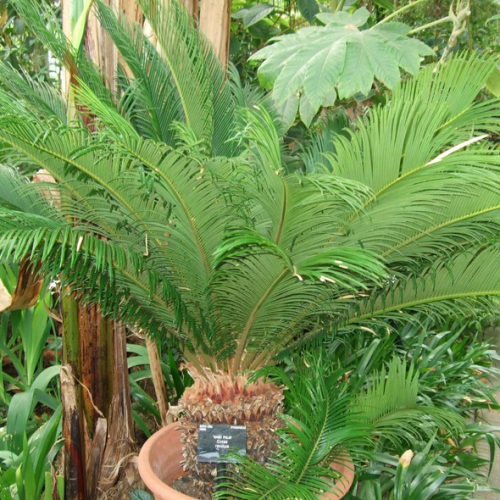Indoor plants Cycas

Description
Characteristic Features of Cycas
Cycas is the only genus of evergreen plants recognized in the family Cycadaceae. It contains 93 species native to Madagascar, the islands of Fiji, Samoa and the Marianas in the southern and western parts of the Pacific, Australia, Indonesia, and other Asian countries from Japan to Sri Lanka. The species are trees that grow to 2 to 15 meters tall when mature. Due to their palm-like appearance, they are sometimes called Sago Palms. The name is not quite correct because a true sago palm is the palm used for obtaining starch from its trunk for the production of sago. There are about fifteen such starch-yielding species out of 93. They are endemic to New Guinea, the Malay Archipelago, and Thailand.
Cycas revoluta (King Sago, Sago Cycad, or Japanese Sago Palm) is grown in homes, offices, lobbies, conservatories, and greenhouses. A mature plant reaches 2–3 meters tall and is therefore cultivated in tubs. Cycas revoluta lives for over 100 years. The species is native to the subtropical Kyushu and Ryukyu Islands in Japan and Fujian Province in China, as claimed by its patriots. Only the first version is reflected in English (Japanese Sago Palm) as well as in German (Japanischer Palmfarn), French (Cycas du Japon), and Czech (Cykas japonsky).
The trunk is sturdy and cylindrical, up to 1.5 meters in diameter, covered by dry leaf-bases. At the base, numerous offsets develop with time. The plant is topped with a tight rosette (1–4 meters across) of dark green leaves (100–240). The leaves are very attractive, arching, drooping, and pinnate with narrow (8–10 millimeters wide and up to 25 centimeters long) hard leaflets. This species is well-known far beyond their natural habitat both for its beauty and tolerance to somewhat cold temperatures. It is not uncommon to see this plant outdoors in parks, for example, in the Crimea or on the Black Sea coast.
Be careful: All parts of this plant (especially the seeds) are poisonous and can harm people and pets if ingested! Standard clinical symptoms of ingestion will develop within the next few hours and may include vomiting, nausea, weakness, and seizures. Unfortunately, pets are at particular risk, since they seem to find the leaves and other parts of the plant very palatable.
Interestingly, in indoor cultivation the plant does not grow taller than 60 centimeters. However, despite the modest size, its exotic look will be bringing back memories of beach holidays and make you feel good.
The Secrets to Successfully Growing Cycas
Cycas needs bright filtered light. In the summer, protect it from direct sunlight to avoid burns.
Cycas is very sensitive to waterlogged soil so allow the soil dry out between waterings (at least, the soil top). Water moderately and reduce watering in the winter.
The plant requires high air humidity (not less than 50%). Make sure to mist regularly.
The best temperatures are 23–26 ° C in the summer and 16–19 ° C in the winter. Do not allow the temperature to drop below 12 ° C.
During the active growth period from April to August, fertilize Cycas once every 2 weeks with palm tree fertilizer. You can use other houseplant fertilizer but make sure it does not contain calcium and magnesium salts. Gradually reduce the feeding frequency. As early as in October, feed no more than once a month and cut the fertilizer strength in half.
Cycas is not affected by repotting. Repot the plant every year, especially when potbound, until the plant is 5 years old. Then repot once in every 4 or 5 years. For mature plants, top dressing is sufficient (5 centimeters of soil). Good drainage is required. Prepare the soil mixture from lightweight clay loam, humus, leaf mold, peat, and sand at 2:1:1:1:1 with the addition of some charcoal. There is a simpler soil mixture: loam, leaf mold, and sand at 2:3:1. The soil should be weak acidic (pH = 5.0–6.0) or neutral (pH = 6.0–7.0). Remember not to plant the trunk too deep into the soil.
Propagating can be done:
1) By removal of pups. Cut an offset, powder the cut with sulfur or charcoal, dry up for a few days and plant in a mixture of leaf mold, peat soil, and sand. Water very moderately. The soil should be only slightly moist. Maintain the temperature of 20 ° C, i.e. no extra heating is required. Consider using rooting stimulants.
2) By seed. However, you will have to wait for shoots for a few months (at least two months), even when the soil is heated up to 30 ° C.
Cycas does not need pruning.
Potential Problems
Overwatering can cause root rot and the plant may eventually die.
Soil acidification can lead to the same outcome.
If the ait is dry, leaves first turn yellow and tips dry up, then the plant will drop leaves.
Defoliation can also occur because of too high temperatures in the winter.
The most common pests that affect Cycas are:
- Spider mites. They thrive in dry air and are too small to see. Signs: webbings, withering and yellowing leaves, leaf drop. Wipe the foliage with a soapy sponge and wash with warm shower. If the time is lost and visible effects cause serious concern, use 0.15% Actellic solution (1–2 milliliters per one liter of water).
- Thrips. They are aided by high temperatures and low humidity. Signs: the upper side of the leaf becomes greyish brown with a silvery sheen. Treat with insecticides (Actellic, Dekametrin-Decis, and Fitoverm). If necessary, repeat the treatment a few times.
- Scale insects. Signs: brown patches appear on the surface of the leaves, the leaves lose colour, dry out, and die. Apply 0.15% Actellic solution.







 5 350
5 350






